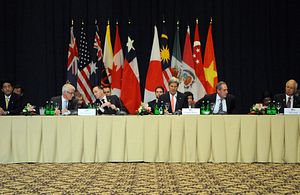Now that the negotiating parties to the Trans-Pacific Partnership (TPP) have settled on a final agreement, the next step is for each of the member states to ratify the pact. The Fletcher School’s Daniel Drezner, writing at the Washington Post, has an excellent run-down of Congress’s reactions to the TPP agreement.
On the surface, the reactions certainly seem to make congressional ratification challenging. Throw in the added complication of a murky presidential primary season along with June’s debacle over the trade promotion authority bill (TPA) and it could be easy to assume that eight years of negotiations won’t look so bad once Congress gets its turn. It might look ominous, and Congress is certainly skilled at creating fights. But the outlook for TPP shouldn’t be so gloomy for several reasons.
First, As Drezner acknowledges, everyone he quotes in his piece said exactly what they’d be expected to say at this point—that passage is not a foregone conclusion, that members will parse the text to ensure the best deal for American workers, and so on. Those that are already opposed, like Bernie Sanders and Rosa DeLauro, were likely always going to be opposed. In fact, it would be more troubling for TPP’s chances if members were changing their positions. So far the reaction is basically what would be expected at this point.
Second, the problem with the earlier TPA vote wasn’t necessarily with TPP itself so much as it was with the Obama administration’s legislative strategy for securing TPA. Trade is always a difficult vote for Democrats, and TPA was no exception given the extent to which unions lobbied aggressively against the agreement. Once Medicare cuts were floated as a means to pay for Trade Adjustment Assistants – a retraining program for workers displaced by trade agreements and a priority for Democrats – supporting TPA became a bridge too far for many of them. But with TPA ultimately secured, those concerns should be in the past given that TPA allows only an up-or-down vote on the agreement without amendment. In other words, the disputes that initially derailed TPA should be a non-issue once TPP comes before Congress.
Finally, the presidential primary season probably won’t have a decisive impact on TPP’s outcome in Congress. Following TPA’s provisions for congressional review, once President Obama notifies Congress of his intention to sign the agreement, Congress’s 60- and 90- review periods would begin. That means that if President Obama informs Congress sometime this fall, congressional consideration would begin sometime in spring 2016. While this would be in the midst of the presidential primaries, the situation is similar to when Congress considered permanent normalized trade relations with China during the 2000 presidential election. In that case, a legislative item that was certainly controversial was still completed without having much of an impact on the election.
Though Sanders and most likely a few Republicans will seize on TPP (provided they’re still competitive next spring), there’s no reason to expect the agreement to be a major campaign issue. Hillary Clinton will need to be careful not to distance herself from the agreement given her earlier involvement with the administration’s pivot to Asia. Joe Biden (assuming he runs) will certainly support the agreement given his role in the administration. Meanwhile, Republican positions will be complicated given the party’s conflicting positions on trade and business policy.
That said, the administration and trade supporters in Congress will still need to get their strategy right. The same groups that pushed so strongly against TPA will return in full force. And there are almost certainly op-eds being drafted now that will sound alarm over provisions of the text once it’s released to the public. The administration and congressional leaders cooperated admirably on TPA and can be expected to do the same for the final agreement. But the administration’s strategy for TPA and its aloofness – with President Obama making his appeal at the very last minute – frankly made the TPA victory more difficult than it needed to be and probably cost votes.
A protracted fight in Congress would be an unfortunate outcome for the agreement the TPP negotiators settled on. By all accounts so far, the U.S. Trade Representative and its negotiating partners delivered a strong agreement that is worth defending and answers many of the criticisms that were leveled against TPP throughout the negotiations. On substance, TPP is a markedly different agreement than the North American Free Trade Agreement (NAFTA), containing enforceable chapters on labor and the environment that NAFTA only considered as side agreements. The agreement’s “open architecture” approach –meaning that provisions can be updated and strengthened if improvements are necessary – gives members of Congress who are on the fence about the agreement an opportunity to express reservations about the agreement as currently formulated, but still vote for ratification with the expectation of strengthening the agreement in the future.
Support in Congress is certainly possible if the administration can make the case. U.S. Trade Representative Michael Froman has been meeting regularly with members of Congress throughout the summer. And if President Obama can weigh in with members the way his did with TPP leaders towards the end of negotiations, the process should be relatively painless. It’s too optimistic to say that the votes are already there, but they’re certainly achievable.
Paul Nadeau is an independent writer based in Tokyo, Japan.

































